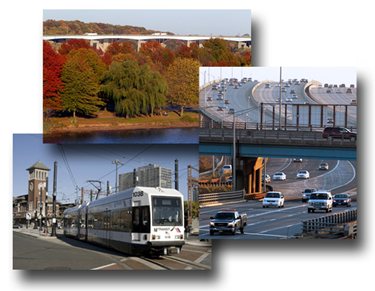Goals & Objectives
Maintaining the performance of the northern New Jersey transportation system in serving one of the nation's most densely-populated regions presents many challenges. Improvements in the transportation system must be made compatible with the achievement of regional goals involving environment protection, quality of life, social equity, efficient land use and public safety. This page lists the goals and planning factors that guide NJTPA decision-making. They provide the foundation for the region's long-range transportation plan, Plan 2050.
 The NJTPA is guided by seven goals:
The NJTPA is guided by seven goals:
-
Protect and improve natural ecosystems, the built environment and quality of life.
-
Provide affordable, accessible and dynamic transportation systems responsive to all current and future travelers.
-
Retain and increase economic activity and competitiveness.
-
Enhance system coordination, efficiency, overall safety and connectivity for people and goods across all modes of travel.
-
Maintain a safe, secure and reliable transportation system in a state of good repair.
-
Create great places through select transportation investments that support the coordination of land use with transportation systems.
-
Improve overall system safety, reducing serious injuries and fatalities for all travelers on all modes.
The NJTPA prioritizes proposed projects according to how well they meet criteria and performance measures related to each goal. The goals also provide direction for the NJTPA’s planning activities and those of its member agencies.
NJTPA’s goals are consistent with the priorities established in federal law. In particular, the current law governing MPO planning isfederal Infrastructure Investment and Jobs Act (IIJA), signed into law on November 15, 2021. It requires performance-based planning, consolidates funding programs while providing more flexibility between them and streamlines certain aspects of project development. It establishes ten planning factors, each of which are related to NJTPA’s goals, as follows:
-
Support the economic vitality of the metropolitan area, especially by enabling global competitiveness, productivity, and efficiency;
-
Increase the safety of the transportation system for motorized and non-motorized users;
-
Increase the security of the transportation system for motorized and non-motorized users;
-
Increase accessibility and mobility of people and freight;
-
Protect and enhance the environment, promote energy conservation, improve the quality of life, and promote consistency between transportation improvements and State and local planned growth and economic development patterns;
-
Enhance the integration and connectivity of the transportation system, across and between modes, for people and freight;
-
Promote efficient system management and operation;
-
Emphasize the preservation of the existing transportation system;
-
Improve the resiliency and reliability of the transportation system and reduce or mitigate stormwater impacts of surface transportation; and
-
Enhance travel and tourism.